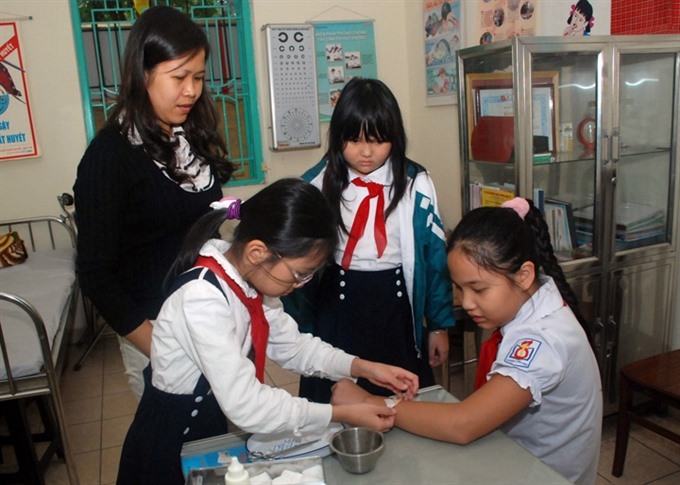 Society
Society

Nguyễn Tài Thành, a medical worker at Quốc Oai High School in Hà Nội feels put under great pressure at work.
 |
| Students get first-aid instruction in the infirmary of Ha Noi’s Quang Trung Primary School. — Photo nhandan.com.vn |
HÀ NỘI – Nguyễn Tài Thành, a medical worker at Quốc Oai High School in Hà Nội feels put under great pressure at work.
The school, in Quốc Oai District, has nearly 1,900 students studying per day, while he is the only medical worker.
The greatest pressure, Thành said, was that he must work two back to back shifts per day from 7.15am to 5pm, six days per week.
Students can be unsafe when school starts, or fall on school grounds, or suffer from falling blood pressure at midday, he said.
“I’m not present to resolve problem, their health can be seriously affected,” he said.
Although Thành tries his best, he worries that with such a great amount of work, he can not control all problems.
Challenges
Schools in Hà Nội often have many students, several even have more than 2,000 students, so medical workers face many challenges.
The education sector does not have any regulations on how many medical workers schools should have compared with the amount of students. In fact, each school has only one medical worker. And in some schools, medical workers must do other jobs as well.
Văn Như Cương, head of the board of directors of the Lương Thế Vinh High School, said that one of the reasons for the problem was that the education sector did not have an official professional faculty for medical workers.
School medical workers face as much pressure as medical workers in hospitals, but with their low income, few people wanted to do work for long, said Cương.
Equipment, manpower shortage
About 10,000 schools across the country do not have official positions for medical worker as regular members of staff, equivalent to 25 per cent of total schools in the country.
Incomplete education ministry statistics show that 90 per cent of schools in the central province of Thanh Hóa do not have an official position for a medical worker as a regular member of staff.
In Hà Nội, Phạm Xuân Tiến, deputy director of the municipal Department of Education and Training, said that the capital has more than 2,500 schools from kindergartens to high schools, and every school had medical workers.
Tien said that medical workers were always present at schools to take care of students’ health, supervise food safety and hygiene in school kitchens, and educate students on epidemic prevention.
More than 90 per cent of the schools have professional medical workers, with teachers doing the work of medical workers at the other schools. About 90 per cent of medical workers at schools are regular members of staff.
One of the reasons why not all medical workers are regular members of staff was that since 2015, schools had to temporarily suspend medical workers to check their quality, per Government requirements.
Thus, Tiến said, schools founded since 2015 can only sign short-term contracts with medical workers.
Most medical workers had basic skills for healthcare services at schools, Tiến said.
Targets
Ngũ Duy Anh, director of the Department of Student Affairs under the Ministry of Education and Training (MoET), said that the role of health services in schools was detailed in Instruction 23 of Prime Minister Nguyễn Tấn Dũng, issued in 2006.
To realise the instruction, the MoET implemented different measures to improve school healthcare services, and considered healthcare as an important duty of schools.
Anh said that after 10 years of implementing the instruction, schools had set up infrastructure, manpower and equipment for healthcare services. But schools struggled to improve their healthcare services.
At central level, only three or four officials supervise healthcare services at schools.
At provincial and municipal level, each department of education and training must have one doctor supervising healthcare services. But in fact, 90 per cent of the officials doing the supervision are teachers.
At district level, only 30 per cent of departments of education and training had officials supervising healthcare services, and all of them are teachers.
To improve healthcare services at schools, Hà Nội is re-checking and setting up plans to give more training to medical workers.
Deputy director Phạm Xuân Tiến said that although about 95 per cent of schools in the city had a well-stocked room for healthcare services, the services still need more investment to properly care for teachers and students.
In December last year, Hà Nội held a competition for excellent school medical workers for the first time.
The competition was an occasion for school medical workers to share experience and learn from each other, and for educational managers to pay more attention to school healthcare.
Tiến said that soon, the city would regulate that schools must pay a fixed amount of money per school year for healthcare services.
The city plans to strengthen supervision of medicines at schools with requirements that every school have enough regulated medicine with medical workers present in the healthcare room every day. – VNS




